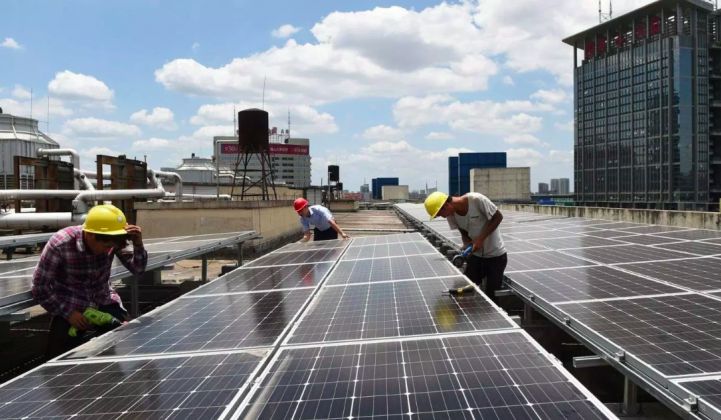General Electric is a big and sprawling company that’s undergone some dramatic reorganizations over the past few years, particularly in its renewable energy, energy storage and grid edge business lines.
But over the past four years, amid these large-scale corporate changes, a small unit of GE has built a growing business around developing distributed solar and solar-plus-storage projects.
On Tuesday, GE announced it’s taking this business to a new stage, via a partnership and majority investment by asset management firm and heavyweight renewables investor BlackRock Real Assets.
The new company, named Distributed Solar Development, will be 20 percent owned by GE Renewable Energy and 80 percent owned by a fund managed by BlackRock. The business, which has been incubated within GE since 2012, will focus on commercial, industrial and public-sector customers.
Erik Schiemann, CEO of Distributed Solar Development and a veteran of various GE business units, said in an interview that the investment would allow the company to expand its current project development work — and, for the first time, own the projects it’s developing.
“What we specialize in at Distributed Solar Development is the origination, development, design, execution, building, and asset management of distributed solar and storage projects,” he said. Most of its projects to date have been behind-the-meter.
“BlackRock’s investment further advances our growth in that platform, allows us to take on new markets, and allows us to double down in the markets we’re currently successful in.”
And while the business hasn't owned any of the projects it’s developed to date, that’s set to change with BlackRock’s investment. “The cash infusion allows us to participate as an owner of the assets,” he said.
BlackRock's push into distributed energy resources
BlackRock Real Assets has primarily invested in utility-scale renewables, with $5 billion invested in over 250 wind and solar projects with a total generation capacity of over 5.2 gigawatts. But it has made moves into distributed-scale solar projects this year, including April's undisclosed investment into small-scale solar project owner CleanCapital.
David Giordano, global head of renewable power at BlackRock, said, “This investment will deepen our clients’ access to the tremendous growth potential in the U.S. solar industry."
Distributed Solar Development has developed about 125 projects in 15 states, working with a variety of solar PV system providers and a set of regional electrical contractors, Schiemann said.
It has specialized in carport solar PV systems — “Our canopy solution, whether it’s in a carport or on top of a parking deck, is a big part of our volume, and something we’ve really differentiated” — and about two-thirds of its projects are behind-the-meter.
But it has also developed rooftop and greenfield projects, as well as front-of-meter, distribution-grid-connected systems, he said.
Battery storage systems now make up a small portion of its projects, but “a majority of our West Coast projects now have a high attach rate of storage,” he said, matching broader trends for solar power in those markets. “In most of the key states known for storage, almost all of our proposals and solutions incorporate them now.”
The U.S. commercial solar market has contracted in 2018 and 2019, according to Wood Mackenzie Power & Renewables, largely due to increasing market saturation and shifts to less favorable rate structures and incentive programs in key states such as California, Minnesota, Massachusetts, New York and New Jersey.
But WoodMac data also shows that developer-owners have captured an increasing share of this more challenging market, compared to those that limited their involvement to acquiring projects, while third-party financed projects have grown from about a third of projects in 2015 to more than half of all projects as of last year.
GE's bumpy road through the solar landscape
Schiemann first started developing projects while working for GE’s PrimeStar thin-film solar PV manufacturing business, during the period when the company decided to abandon the field by selling it to First Solar.
“I started pushing us in startup fashion toward distributed solar and distributed solutions,” and the company started landing commercial contracts in 2012, he said. This project development work continued during his time at GE’s Current and then at GE Energy Ventures.
GE still makes solar inverters, switchgear and other solar-related equipment, and is heavily involved in financing and investing in large-scale wind power projects.
GE is among the world's leading suppliers of onshore wind turbines and has big ambitions for the offshore market. Meanwhile, its approach to the solar, energy storage and distributed energy markets has shifted dramatically over the past few years.
In 2015, GE created its Current business with $1 billion in investment, meant to bundle smart lighting, solar, EV charging, energy storage and energy management services for commercial and industrial customers. But in late 2016, it underwent a major restructuring that essentially stripped Current down to smart lighting and building energy management, and in 2018 it sold that business to private equity firm American Industrial Partners.
In 2018, GE’s energy storage business was shifted to GE Power, while the company underwent a broader restructuring that led to the formation of GE Renewable Energy as a standalone business unit, to house its renewable energy and grid assets, including solar, storage, wind and hydropower.
Solar remains a tiny fraction of GE's overall renewables business; onshore wind accounted for nearly 90 percent of the Paris-based Renewable Energy segment's revenues last year, with hydro chipping in most of the rest.




